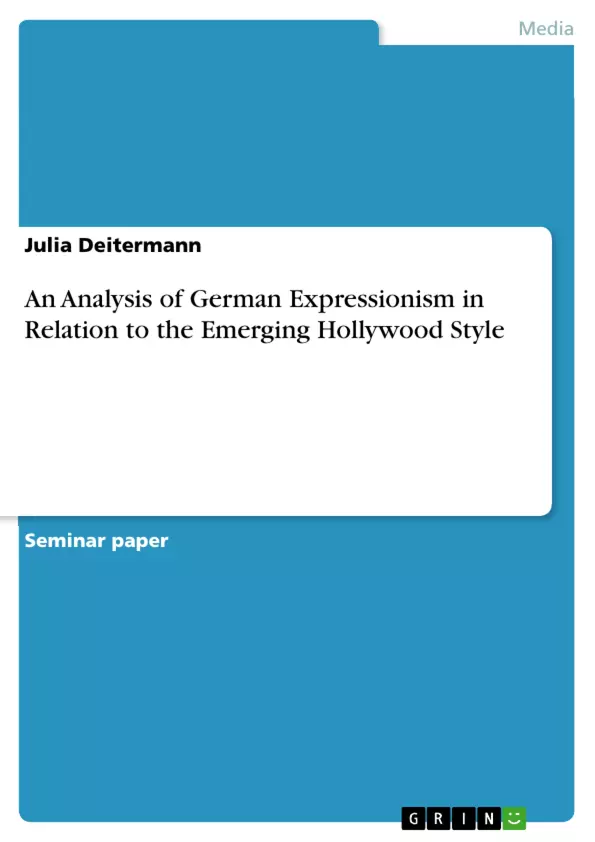In the first twenty years of film history, Hollywood had already conquered large parts of the world through the creation of artistic silent films. While American filmmakers, such as D. W. Griffith, focused on montage, continuity, and coherence as a means of narrating a story, thus making the narration more comprehensible and the characters more reliable, German filmmakers predominantly emphasized the mise-en-scène of the film when they created a new genre - the Expressionist film. In general, Expressionism is a term used for the distorted representation of reality which attempts to reveal an inner vision of the soul that is shaped by fear and wonder at the same time. The rise of German Expressionism after World War I can be traced back to a number of reasons. First of all, society was shattered by years of war and the rapid changes that had taken place in the last decade. The political system of the monarchy was abolished to pave the way for a parliamentary democracy. However, the Weimar Republic was politically instable, a revolution was put down and economy was not flourishing. The cultural movement of Expressionism represented all the changes in society, among them industrialization, the boom of radio and film, and Einstein’s and Freud’s revolutionary approaches to the world; all of which provoked the need of a new representation of reality. Moreover, people not only longed for entertainment and distraction in this insecure new world, but also did they inherit a new sense of “intellectual liberation” after censorship was ended and women were allowed to vote. Furthermore, the German film industry lacked film imports from other countries and decided to become involved in international film business itself, thus creating the large film company Ufa (Universum Film AG) that still exists today. Ufa produced films of various genres, but the most popular and influential in the world was to become the Expressionist film. Expressionism insofar forms a sharp contrast to Impressionism and Naturalism, as it does not attempt to depict momentary impressions of the world, nor does it aim at presenting the physical world as it is. On the contrary, it portrays an interpreted psychological and spiritual reality, thus revealing the underlying essence and meaning of things. As a result, reality can be seen as a creation of the mind, which calls for the viewer’s interpretation.
[...]
Inhaltsverzeichnis (Table of Contents)
- An Analysis of German Expressionism in Relation to the Emerging Hollywood Style
- German Expressionism and the Hollywood Style
- The Mise-en-scène of Expressionist Film
- The Camera as a Window into the Mind
- Griffith's Style as a Contrasting Example
- Expressionist Films and the Genre of Film Noir
- The Cabinet of Dr. Caligari
- The Grotesque World of Expressionism
- Expressionist Films and the Studio System
- Lighting and the Use of Chiaroscuro
- Stylized Acting in Expressionist Films
Zielsetzung und Themenschwerpunkte (Objectives and Key Themes)
This analysis aims to explore the unique visual style of German Expressionist films and contrast it with the emerging Hollywood style of the early 20th century, emphasizing the role of mise-en-scène, camera techniques, and acting in shaping these distinct aesthetics.
- The influence of societal changes and artistic movements on the emergence of German Expressionism.
- The stylistic differences between German Expressionism and the Hollywood style, particularly in terms of mise-en-scène, camera work, and editing.
- The use of artificiality and distortion in German Expressionist films to represent psychological and spiritual realities.
- The impact of Expressionism on the development of film noir and its enduring influence on cinema.
- The significance of the camera's role in revealing inner visions and subjective experiences in both Expressionist and Hollywood films.
Zusammenfassung der Kapitel (Chapter Summaries)
- This chapter introduces the emergence of German Expressionism in the context of post-World War I Germany, highlighting the societal and cultural factors that contributed to its development. It contrasts the Expressionist approach with the Hollywood style, emphasizing the significance of mise-en-scène in creating a distorted and subjective representation of reality.
- This chapter examines the camera's role in conveying inner visions and emotions in Expressionist films, contrasting it with the more objective approach of D.W. Griffith. It explores how the camera becomes an active participant in the narrative, mirroring the characters' thoughts and feelings.
- This chapter focuses on the stylistic elements of German Expressionism, such as the use of artificial scenery, distorted perspectives, and chiaroscuro lighting. It contrasts this approach with the more realistic aesthetic of Hollywood films and demonstrates how these techniques create a nightmarish and unsettling atmosphere.
- This chapter analyzes the influence of Expressionism on the genre of film noir, citing Ridley Scott's Blade Runner as a prominent example. It explores how the distinctive visual elements and themes of Expressionism continue to resonate in contemporary cinema.
- This chapter examines the film The Cabinet of Dr. Caligari as a prime example of German Expressionism. It discusses the film's plot, setting, and stylistic features, highlighting how the distorted reality of the film reflects the psychological and spiritual anxieties of the time.
Schlüsselwörter (Keywords)
This analysis focuses on the key concepts of German Expressionism, Hollywood style, mise-en-scène, camera techniques, editing, artificiality, distortion, subjectivity, film noir, and the film The Cabinet of Dr. Caligari. It explores the contrasts between these two cinematic approaches and investigates the influence of Expressionism on the development of film noir.
- Citation du texte
- Julia Deitermann (Auteur), 2004, An Analysis of German Expressionism in Relation to the Emerging Hollywood Style, Munich, GRIN Verlag, https://www.grin.com/document/61098



